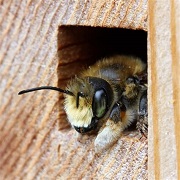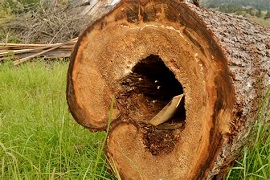Just Bee Kind - continued

Currently there are over 20,000 species of bee that face extinction. It would be very human-centric to find solace in the fact that there are still plenty of honey bees. These are under threat as well if the environment they rely upon is severely impacted upon by the overall decline. Bees like a lot of the same things we do in the environment; clean air, water and a rich diversity of life. Bees will play an important role in the attempts to tackle climate change.
Honey bees are probably the best known type of bees but there are many other varieties, which don’t produce honey. Honey bees and bumblebees live socially. They have a Queen who leads the hive and is serviced by female worker bees and male drones. Solitary bees tend to be smaller and a family unit is made up by a pair. They are sometimes found living in the same area as other solitary bees but they operate alone.
 In the UK, 13 species of bee have become extinct since 1900. Currently there are a further 35 species on the brink of extinction. In Europe, 1 in 10 of the wild bee population face extinction. Farming practices, pesticides, disease, pollution, habitat loss, non-native plant and animal intrusion and climate change have all contributed to the decline of bee species and populations.
In the UK, 13 species of bee have become extinct since 1900. Currently there are a further 35 species on the brink of extinction. In Europe, 1 in 10 of the wild bee population face extinction. Farming practices, pesticides, disease, pollution, habitat loss, non-native plant and animal intrusion and climate change have all contributed to the decline of bee species and populations.
There are millions of species of animals currently in danger of extinction. For most of us, the plight of the black rhino, for example, is something that we are resigned to observing at a distance, powerless to help in a real sense. The fate of the bees however is not beyond our capacity to do something locally to aid the maintenance and recovery of populations. Most people can do a few simple things that can make a big difference.
Planting nectar rich flowers helps bees to find the food they need. Even if you live in a tower block, a nectar rich window box in an urban jungle is of great value to all pollinators including bees. Avoid the ornamental flowers which sometimes have no nectar. Herbs are a firm favourite, especially marjoram, chives, sage and thyme.

For those of you with gardens, a great way to help bees is to provide them with a ‘bee hotel’ or bee friendly living spaces such as a deadwood area. This will attract the solitary bees to the garden. The solitary bees need individual nests. Different species look for different places to call home. Some tunnel into the ground, crumbling mortar or sandy banks. Others seek out holes in wood and hollow stems. By offering areas in your garden with this material, bees will be attracted. They also need water. A bird bath, pond or fresh water put out daily during hot periods will ensure that the bees are able to make your garden their home.
Creating areas in your garden that have more natural conditions is a better solution than items such as bee or insect hotels. The more natural the conditions the more they will evolve, if allowed to, into spaces that offer more than just items like bee and insect hotels. Deadwood, and logs perhaps with a series of holes drilled into them, can become a natural feature that serves to protect the wildlife and offer you something that feels balanced and satisfying – ie a nesting bird in the bush has a better sense of natural well being, than a bird box nailed to a tree does! If the options and choices are limited, a bee hotel is a good way to encourage and enjoy nature in your garden.
For those of you who wish to find out more about creating good environments for bees and other wildlife in your garden, try exploring the links.
Gardeners World - How to make a bee friendly garden.
Woodland Trust - How to build a bee hotel.






